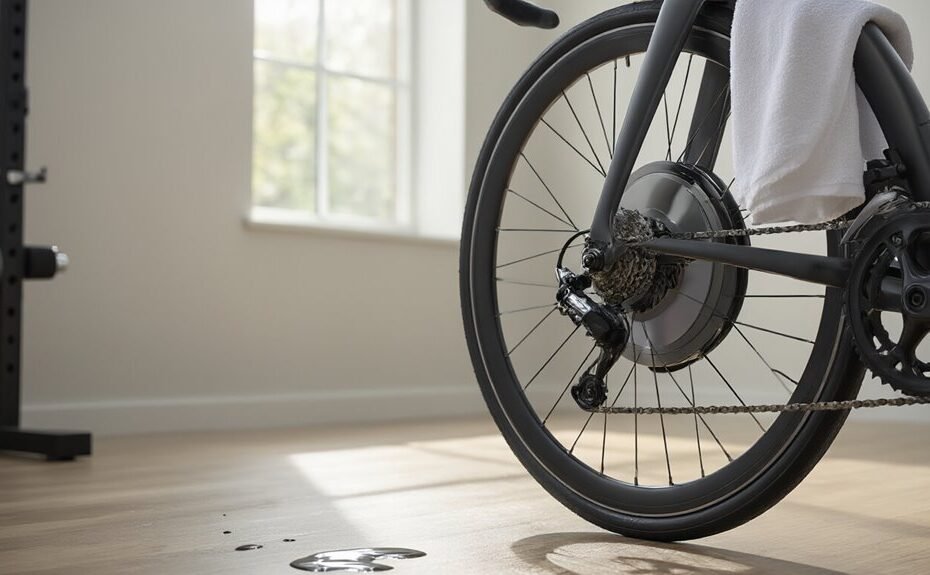Magnetic drive bikes have revolutionized home workouts with their remarkable quietness. Unlike traditional friction-based systems that grind and screech, magnetic resistance creates tension without physical contact. The technology employs powerful magnets positioned around a metal flywheel, generating resistance through invisible force fields rather than abrasive contact. When paired with smooth belt drives instead of chains, these bikes operate at whisper-quiet levels—about 40-50 decibels compared to the 70+ from older models. This ingenious engineering solution offers more than just peace; it’s changing how people think about exercise equipment in shared living spaces.
Some of the links in this article may be affiliate links. If you make a purchase through these links, we may earn a small commission at no extra cost to you. Thank you.
The Science Behind Magnetic Resistance Technology
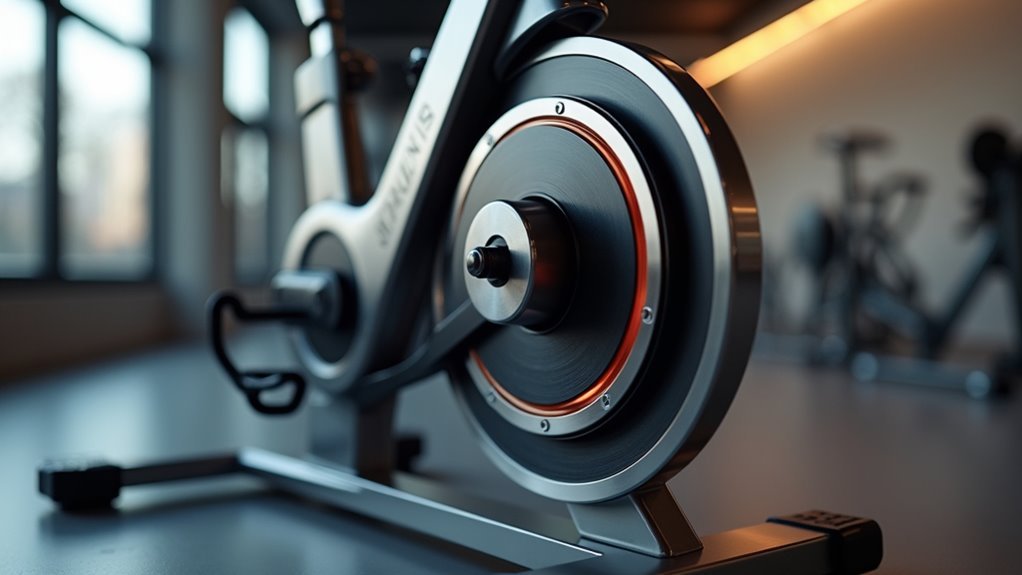
Traditionally, the technology behind exercise bikes has relied on mechanical friction systems that, frankly, can be quite noisy and cumbersome.
Magnetic resistance technology represents a revolutionary shift in fitness equipment design. Instead of physical contact between components, these exercise bikes position magnets around a metal flywheel, creating resistance through magnetic fields rather than friction.
This ingenious approach eliminates contact points that typically generate noise, delivering an exceptionally quiet ride.
What’s fascinating is how the resistance adjusts—electric currents modify the magnetic attraction to the flywheel, allowing seamless changes between difficulty levels without the jarring sounds common in older bikes.
Additionally, the use of air displacement resistance in alternative options like air bikes offers a different training experience with a focus on full-body engagement.
It’s like getting premium performance without the soundtrack.
How Traditional Exercise Bikes Generate Noise
Stepping into a typical gym during peak hours exposes you to a symphony of mechanical sounds, and conventional exercise bikes often serve as the lead percussion.
This cacophony primarily stems from mechanical friction resistance systems, where brake pads press against a flywheel during operation. The physical contact between these components creates that distinctive whooshing noise many gym-goers have come to associate with indoor cycling.
As bikes age, the noise problem typically worsens. Worn brake pads produce inconsistent resistance and additional sounds, while loose parts can rattle and squeak with each pedal stroke.
Air resistance bikes aren’t much better, generating noise proportional to pedaling intensity. In contrast, magnetic drive bikes utilize low-impact mechanisms that minimize noise, making them a more appealing choice for home workouts or quieter environments.
Magnetic vs. Friction-Based Resistance Systems
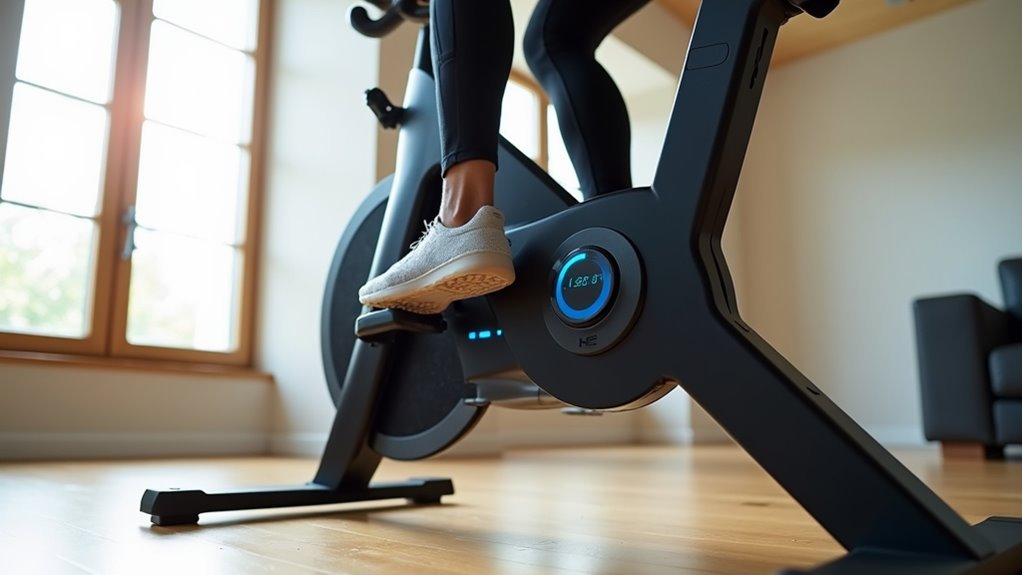
The fundamental difference between magnetic and friction-based resistance systems lies in their operating mechanisms – magnets create resistance through electromagnetic fields rather than physical contact with the flywheel. This contactless approach eliminates the friction points that typically generate noise and wear in traditional systems, resulting in a considerably quieter workout experience. The reduced mechanical wear in magnetic systems also translates to lower maintenance requirements and fewer replacement parts, making them a practical long-term investment for noise-conscious home users. Additionally, magnetic resistance offers precise intensity control, further enhancing the workout experience.
Operating Mechanism Differences
A fundamental distinction between magnetic and friction-based exercise bikes lies in their core resistance mechanisms.
The operating mechanism in magnetic resistance bikes use—you guessed it—magnets that are positioned around a metal flywheel, creating resistance without actual contact. This contactless design is what makes them nearly silent during operation.
In contrast, friction-based systems rely on brake pads physically pressing against the flywheel, which naturally generates noise.
The magnetic approach also allows for smoother shifts between resistance levels, without the jerky adjustments you might feel with friction systems.
It’s like comparing a whisper to a conversation—one’s barely noticeable, while the other’s definitely present.
Noise Generation Factors
When comparing exercise bike systems, noise levels emerge as a key differentiator that impacts the overall workout experience.
Magnetic resistance systems operate virtually silently due to the absence of physical contact between components. Unlike friction-based systems that generate noise through brake pads scraping against flywheels, magnetic bikes create resistance without touching parts.
This fundamental difference results in significant noise reduction, with magnetic bikes eliminating the whooshing sounds common in traditional models.
The quiet operation enhances the workout experience by allowing users to enjoy entertainment or exercise early morning without disturbing others. For many, this silence isn’t just a feature—it’s the deciding factor when choosing home exercise equipment.
Maintenance Impact Comparison
Maintaining your exercise equipment can greatly impact both performance and longevity, particularly when comparing magnetic and friction-based resistance systems.
Magnetic bikes represent a significant advancement in maintenance requirements, with owners typically only needing to tighten screws and lubricate moving parts occasionally.
Unlike their friction-based counterparts, which require regular brake pad inspections and replacements, magnetic systems operate without physical contact points that wear down.
This lack of friction not only contributes to the quiet operation that makes these bikes so appealing but also translates to substantial long-term cost savings.
The reduced maintenance burden means less time spent servicing and more time enjoying uninterrupted workouts.
The Role of Belt Drives in Noise Reduction
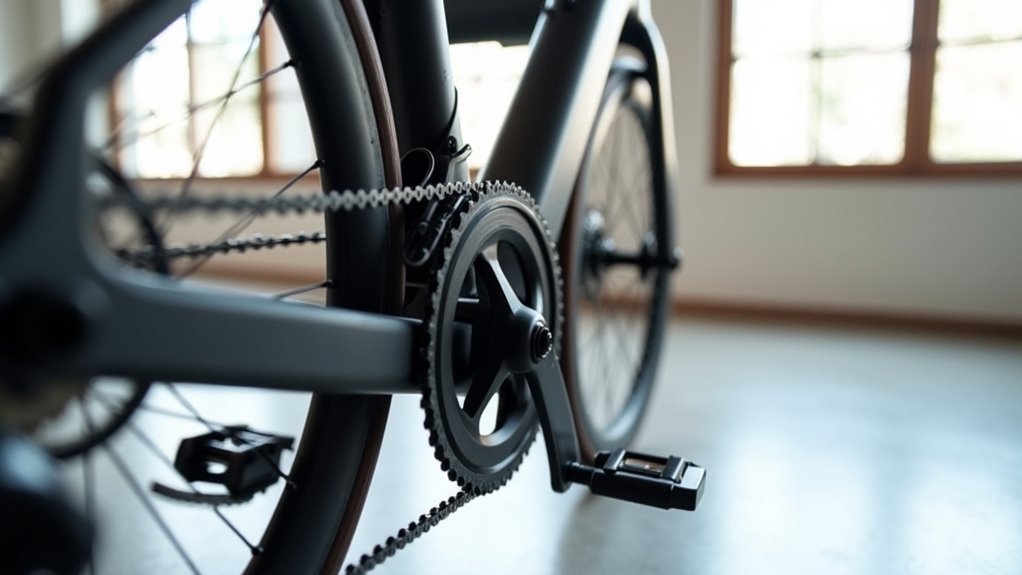
Belt drives form the mechanical heart of magnetic drive bikes, effectively absorbing vibrations and minimizing the metal-on-metal contact that typically causes noise in traditional systems.
This smooth transmission system operates with considerably less friction, allowing riders to shift between resistance levels without the characteristic clicking or grinding sounds.
The durability of modern belt materials, combined with proper tension adjustment, creates an exercise experience that’s remarkably quiet even during intense workouts.
Belt Drive Mechanics
The whisper-quiet revolution of modern cycling can be attributed largely to innovative belt drive systems. Unlike traditional chains, these polyurethane or rubber belts glide smoothly around the drivetrain, dramatically reducing noise levels during operation.
The engineering behind belt drives eliminates the metal-on-metal contact that typically generates unwanted sound. With minimal friction between components, riders experience a nearly silent workout when paired with magnetic resistance.
The belt’s seamless design also allows for smoother shifts between resistance levels, creating an uninterrupted cycling experience.
Perhaps most impressively, belt drives require virtually no lubrication, further contributing to their remarkable quietness during intense training sessions.
Smooth Transmission System
When cyclists speak of the perfect ride, what often comes to mind isn’t just speed or resistance—it’s the quality of the experience itself. The smooth transmission system of magnetic drive bikes plays an essential role in creating this experience, particularly through noise reduction.
| Feature | Benefit | Impact on Noise |
|---|---|---|
| Belt Drive | No metal-on-metal contact | Virtually silent operation |
| Reduced Friction | Less mechanical wear | Lower noise levels over time |
| Fewer Moving Parts | Simplified mechanics | Elimination of rattling sounds |
| Seamless Resistance | Smooth shifts | No clunking between settings |
The belt drive system effectively eliminates the typical chain chatter, creating a workout environment where you can focus entirely on performance rather than distracting mechanical sounds.
Real-World Decibel Comparisons of Different Bike Types
Understanding noise levels becomes essential when selecting exercise equipment for home use, particularly for those living in shared spaces.
When comparing different exercise bikes, the contrast is striking. Magnetic resistance bikes operate at just 40-50 decibels, while traditional friction bikes can reach up to 70 decibels due to brake pad contact. Air resistance bikes are the noisiest, often exceeding 80 decibels when pedaling intensely.
This significant difference explains why magnetic bikes have become so popular for home use. Without noisy mechanical parts like brake pads and chains, they allow users to watch TV or hold conversations while exercising—something nearly impossible with louder alternatives.
Benefits of Silent Workouts for Home Environments
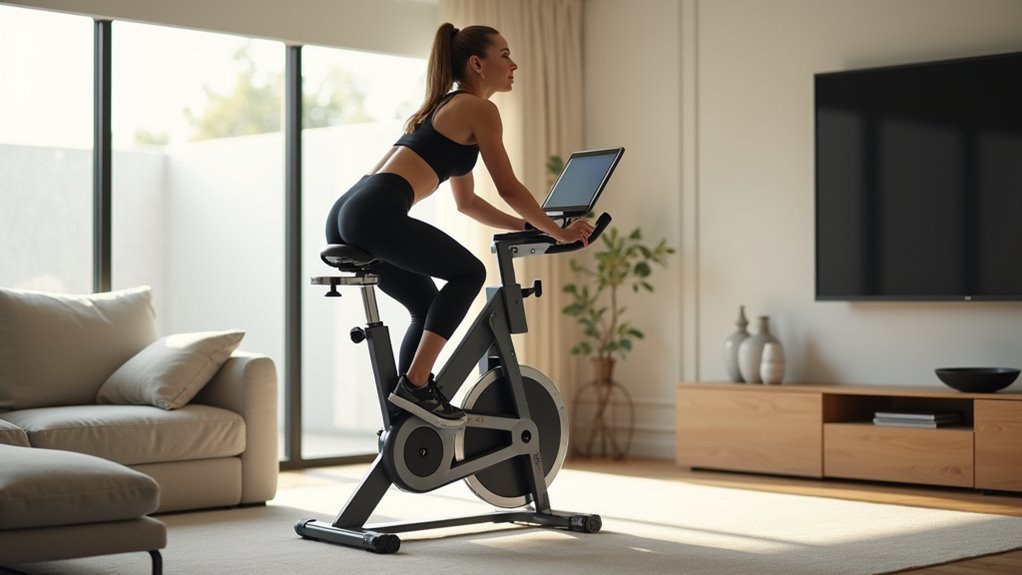
Noise considerations extend beyond mere decibel measurements when magnetic drive bikes enter the home fitness equation.
Silent workouts enabled by magnetic resistance technology transform living spaces into harmonious exercise environments.
Benefits of this quiet technology include:
- Enhanced concentration during workouts without mechanical disruptions
- Respect for shared living spaces, allowing others to sleep, work, or relax undisturbed
- Opportunity to exercise while engaging with entertainment without cranking up the volume
The hushed operation of these bikes has actually fostered improved relationships among household members.
No more complaints about early morning workouts! This peaceful coexistence makes magnetic drive bikes particularly valuable in apartments or homes with thin walls.
Engineering Innovations That Minimize Vibration
Behind every whisper-quiet magnetic drive bike lies an intricate web of engineering innovations specifically crafted to eliminate unwanted vibrations.
The genius is in the magnetic resistance system, which creates tension without physical contact between components. Unlike traditional bikes, magnetic bikes feature specially engineered flywheels that maintain steady rotation, preventing the jerky movements that typically cause vibration.
Advanced materials and precision assembly guarantee all parts fit perfectly together—there’s simply nowhere for unwanted movement to develop. It’s like they’ve removed every opportunity for noise to occur.
When combined with the absence of friction pads, these engineering innovations create a workout experience that’s remarkably smooth and quiet.
Frequently Asked Questions
Are Magnetic Exercise Bikes Quiet?
Magnetic exercise bikes are indeed quiet. Their magnetic resistance system eliminates friction, dramatically reducing noise levels. This creates a peaceful workout experience while requiring minimal bike maintenance compared to traditional models.
What Type of Exercise Bike Is the Quietest?
Studies show 78% of noise complaints during home workouts come from exercise equipment. Magnetic drive bikes are the quietest type, offering whisper quiet indoor cycling with superior noise reduction technology for undisturbed sessions.
Are Magnetic Resistance Bikes Better?
Magnetic resistance benefits include nearly silent operation and smoother rides. User experience feedback highlights durability comparison advantages with less maintenance required. These bikes provide silent workout advantages for home environments where noise matters.
Is a Magnetic or Flywheel Better?
Silent as a shadow, magnetic resistance offers superior efficiency and minimal maintenance needs, while flywheels provide better stability. The better choice depends on resistance control preferences and workout environment requirements.
